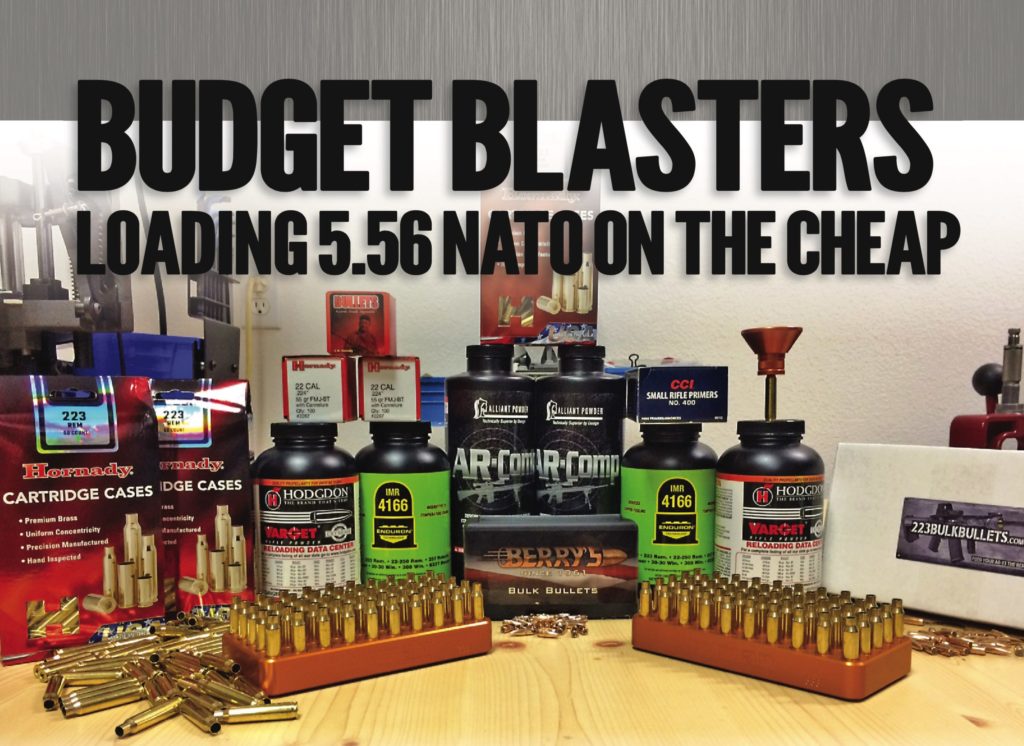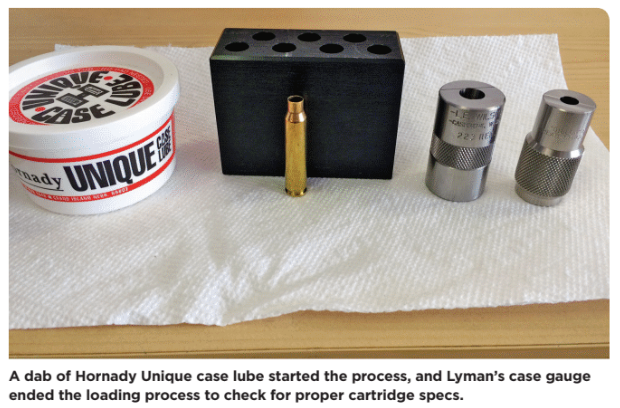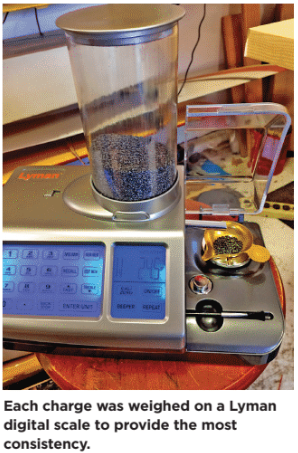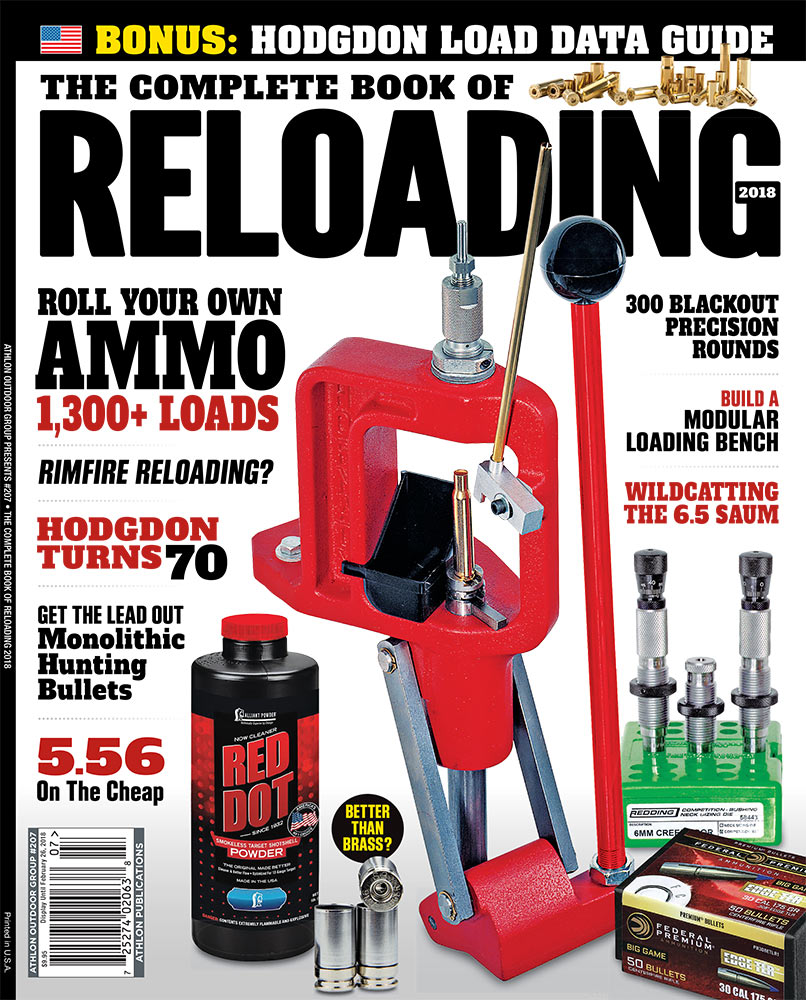
BUDGET BLASTERS LOADING 5.56 NATO ON THE CHEAP
This article was written by Bob Beezley for “The Complete Book of Reloading” for Athlon Media.
WHO NEEDS MATCH GRADE WHEN THE MAIN OBJECTIVE IS TO PUT SOME ROUNDS DOWN RANGE AND HAVE SOME FUN?

Paradise… that’s how my mind feels when I’m handloading ammo… just one at a time. Perhaps it’s the rhythm, or maybe the fact that this is one of the few countries where we can enjoy the freedom and ability to load our own ammo at our own pace that makes this truly one of the best lifestyles in the world.
When I left the war in 2007 and came home, I was searching for something to free my mind. Something to help me focus on tomorrow and not what happened yesterday. I found it in reloading. One might imagine how excited I was when offered the chance to write an article about handloading ammunition.
The premise of this article is to find the most accurate handload for .223 Remington/5.56mm NATO, with commonly available powders and projectiles for the least amount of money.
I have used so many different types of projectiles over the past decade trying to feed my custom AR, I have lost count. Sure, you could pay a lot of money for match grade projectiles, but what about those of us who just want to shoot something that’s accurate and inexpensive? Through trial and error and a bit of range research, I believe I have found a few combinations that just might fi t the bill.

Bench Time
Since one goal is accuracy, I chose to start with new Hornady cases, all from the same lot. Since I had so many cases to process, I started with my Dillon 1050 Super to process the brass fi rst. Loading this much brass, I fi nd it faster to size and prime in one go, then head to the single-stage press to fi nish off the rest of the process. My stand-by is a classic Hornady single-stage press.
Since we want to see how accurate these hand-selected projectiles really are, I wanted to load all three projectiles with the same powder and charge weight so we could really see which bullets proved the most accurate. I used three powders: Varget, IMR 4166 and Alliant’s AR-Comp. The projectiles that I chose to use are all 55-grain full-metal jacket with a cannelure.
 The projectiles came from .223bulkbullets.com, also known as “Bob’s Bulk Bullets,” Berry’s Bullets and Hornady.
The projectiles came from .223bulkbullets.com, also known as “Bob’s Bulk Bullets,” Berry’s Bullets and Hornady.
To keep the comparison equal, each projectile got the same powder charge with the corresponding powder type.
Even though the three different bullets being used are of the same type, there are some slight differences between them. The cannelure are at slightly different locations, requiring different seating depths. All projectile seating depths were set to the center of the cannelure. Following that, seating depth on the cannelure will assure that loaded rounds will not exceed the maximum over-all length of 2.260-inch. This will assure the proper OAL for each specific bullet and brand.
To make the loading process a little easier, I ordered up a set of Lyman loading blocks from Midway. These loading blocks are machined from a single piece of aluminum and are an exact fi t for the .223 Rem cartridge. This ensures that there isn’t any “wobble” with the cases when trying to drop the powder charge, and it doesn’t hurt that it will make any loading bench look great. While using these loading blocks, I also like to use the caliber specific machined aluminum powder funnel from Xtremehardcoregear.com. Since they are made from machined aluminum, they are naturally static-free. They are precision machined to fi t your specific cartridge, so this means no more powder spillage between the funnel and case-mouth. It may not seem like much, but having a loading block and powder funnel that are specific to the task really does help the efficiency of the whole operation.

Range Results
I decided to start with Varget, and I loaded 50 rounds each for the Hornady, Berry’s and Bob’s Bulk Bullets. Each case received a charge weight of 25.5 grains of powder. This left me with plenty of rounds to fi re three 5-shot groups at 100 yards, as well as shoot 10 rounds per batch through a chronograph to get an idea of the shot-to-shot consistency. These rounds had the highest standard deviation (SD), but were still pretty consistent. The best 5-shot group with Varget was with the Berry’s bullet measuring in at 0.68-inch and the largest group measuring 2.16-inch.
The second powder used was IMR 4166. Once again, 50 rounds were loaded for each bullet with a powder charge of 24.5 grains. This powder provided a much tighter extreme spread (ES) and a respectable SD. The largest group fi red measured in at 2.74-inch shooting the Berry’s bullet, and the smallest group shot measured 0.55-inch. An interesting point here is that this group was the smallest five-round group fi red for this article.
The last and final powder used was Alliant’s AR-COMP. This powder was loaded with a charge weight of 23.5 grains for all three types of bullets loading 50 rounds each. This powder had the smallest SD and also provided us with the smallest average group size of 0.98-inch for a string of three 5-shot groups. The projectile fi red in this group was Bob’s Bulk Bullets from .223bulkbullets.com. This projectile performed very well, and had the second smallest group size for this article, measuring in at 0.65-inch. Like I said earlier, this bullet-and-powder combination had the smallest average group size of just 0.98-inch. Considering that the overall cost of this bullet, including shipping, is the lowest of those tested in this article, and are consistently available. These are, in my opinion, the best bullets around for the task at hand.


Parting Shots

A little side note here. While shooting all nine batches of these loads at the range, I did take the time to clean the chamber and bore between each set of three 5-shot groups. This also allowed time for barrel cool-down, too. It is a chore trying to keep the barrel of this rifl e cool while shooting in the middle of the Mojave Desert in August.
All of these powder-and-bullet combos performed well, but there are some that rose above the rest. IMR 4166 with a charge weight of 24.5 grains pushing a Berry’s bullet produced the smallest single group at 0.55-inch, while the .223bulkbullets.com projectile driven by 23.5 grains of AR-COMP powder gave the tightest average group size of 0.98-inch.
When it comes to saving money, it’s pretty simple math. Bought in bulk, brass, powder, primers and bullets are less expensive. Making the assumption that a new brass case will cost 35 cents each, and will be loaded 10 times, the amortized cost come to 3.5 cents per round. Primers cost about 3.5 cents each, too. Powder will cost about 10 cents per round, which is about the same for these 55-grain budget bullets. Added together, the raw materials will set you back about 27 cents per round. A fair comparison on a box of 20 rounds puts the cost at $5.40. Compare that to similar factory loads at $9.00 a box when bought in quantities and you start seeing where the savings come into play.
Perhaps this will help you find a great load at a price that you can afford. Thank heavens that we live in such a great land that gives us the ability to do this. May God bless all of our troops in harm’s way who protect our way of life.

Article originally appeared on The Complete Book of Reloading magazine – January 2018 issue.

